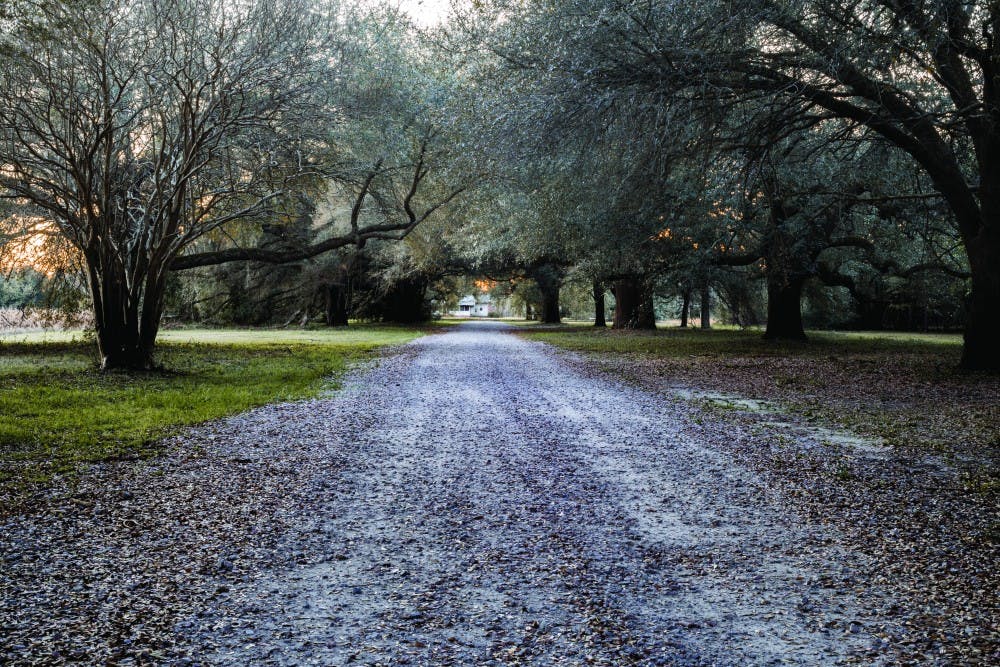DURING SPRING BREAK, MANY USC STUDENTS ESCAPE THE STRANGLES AND STRESSORS OF COLUMBIA TO RELAX ON BALMY BEACHES, OR PERFORM SERVICE WORK IN DEVELOPING COUNTRIES. HOWEVER, STUDENTS WOULD BE REMISS TO FORGET THE FANTASTIC JOURNEYS THAT THEIR HOME OR ADOPTED STATE CAN OFFER.
The backroads of South Carolina are the forgotten treads of old highways, drawn before the interstate system took over. They lead through one-street towns like honeapath, grambling, prosperity, and union, through places that are considered lucky to be mentioned on an interstate sign. And they hold the forgotten culture of the south, one that isn’t built on political ties or separation, but on homeliness, and a pride for where you’re from.
Through my college career, I’ve felt a draw for the old Gothic South found in Flannery O’Connor’s short stories or in the rifts of a Muddy Waters song. Maybe it’s because I’m a writer. Maybe it’s because, as a student born and raised in South Carolina, I’m finally seeing my home state for what it’s worth. Though this history seems to be dead, it can still be found in the worn creases of a map, on the roads, most literally, least traveled by.

“Interstates just don’t make any sense to me,” says Buddy Kirby, a resident of Honeapath, South Carolina. “People are driving too fast, just trying to get from one place to another. They don’t take the time to appreciate the scenery, to appreciate where they are.”
And it’s true. Interstates are a great way to get to where you’re going, but to appreciate where you are, and where you live, you should step off of these roads and into the heartlands of the state. I found the beauty of South Carolina to be truly preserved along these roads. As you drive south from Columbia, with the sun hitting the live oaks and kudzu-ridden fields, there is an austere sense of traveling through time.
This isn’t to say that the political or social climates of past ages are to be desired. The history of the American South is rife with conflict, racism and a darkness that still lurks in these politically trying times. It is hard to learn to love where you’re from when that history is the first foot forward. As a liberal, queer, young person, I struggled immensely with trying to love the South, and equally moving beyond its trying history.
But there is a sense of welcoming, of love and appreciation for others, that comes to light in these small towns. Sylvia Duncan, who owns JD’s Good Food and Community Store, on Highway 601, welcomed me into her restaurant and brought me a glass of water when I said I was working for a student publication.
“I think it’s good to get people out here,” she said. “We need people to come into our community, to see who we are and what we’re doing. That’s the only way places like this will survive.”
Many of these towns were once mill towns, at their liveliest during the textile boom, or towns that prospered by being along a well traveled road. Now that times have changed, they are being taken over by kudzu and abandoned buildings, lot-for-sale signs and empty fields. But even in this degradation there is a sense of beauty, a sense of history and self. To travel by an abandoned house is to see a home, a place where families lived and grew, where history was made. As a writer, these places, to me, hold a sense of identity that is as tied to southern culture as the tumultuous past. There is an identity here that isn’t built on Confederate flags or redneck stereotypes, but rather on family, on sense of place and home.

When asked why they didn’t leave smaller towns for larger cities with more opportunities, like Greenville or Columbia, most residents had the same answer.
“This is my home,” Duncan said. “This is where my parents lived, and their parents before them. This is where I raised my family.”
“I don’t think you could understand, unless you live it, how much a place can mean to you,” Kirby said. “How much it can be tied to who you are.”
But I think I can understand. As cities grow and become more gentrified, and more homogenous, these towns are pockets of culture. They preserve a sense of identity that is important to understand, a piece beyond just the history books. Large events didn’t take place in these towns. They are not famous in the cultural sense of Atlanta, they are not known for their luxury vacation sites or beautiful, well-designed city-centers. But they are equally important, in their smaller, less understood ways. People were born, and died here.
Families grew, and prospered or suffered. If you are from a small town, you may be tired of it. You may see it as backwards, culturally irrelevant, and incomplete. But I implore you to take a step back. Travel down roads that you need a map to find. Stop and talk to owners of the stores and restaurants along the route.
Listen to their stories. And perhaps you will find what I have found. That the best spring break can be spent finding yourself, in the recesses of your home place, where you thought you’ve always lived but never really seen.



